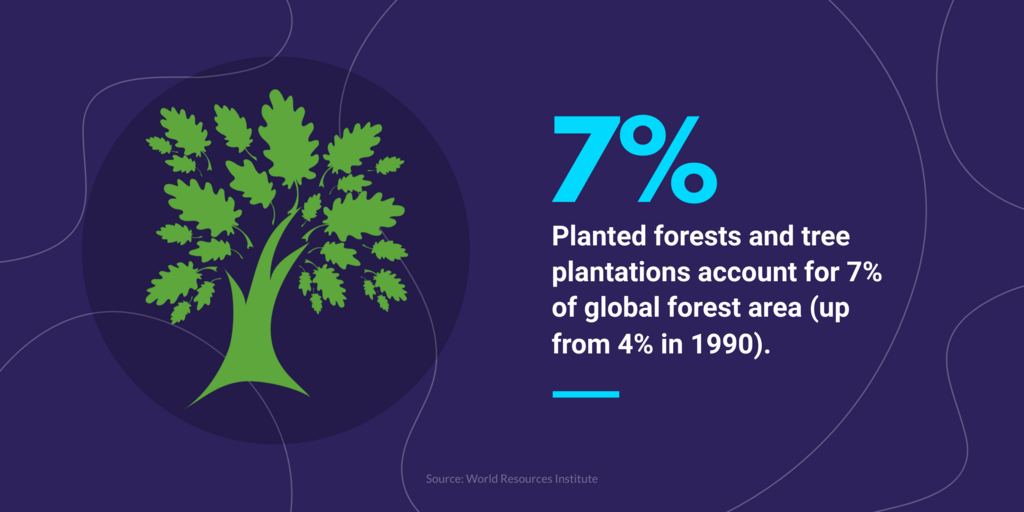Tree Plantations: How Do They Affect the Environment & Local Communities?

Written by
Justin Kuepper
Published on
Jan 11, 2022
Last updated
Jan 31, 2022
Many climate-focused charities and neobanks promote tree planting to fight climate change. After all, trees absorb carbon dioxide and emit pure oxygen. A recent study found that planting a half-trillion trees could capture about 205 gigatons of carbon and reduce atmospheric carbon by about 25 percent—negating about 20 years of human emissions!
Of course, the devil is always in the details. The wrong tree planting strategies can negatively influence local communities and harm the environment. There are countless examples of misguided efforts that displaced indigenous populations, reduced forest resilience, and even sparked massive wildfires that undermined the whole endeavor.
Tree plantations are a natural fit for tree-planting efforts since they involve a high density of trees and only require negotiation with a single counterparty. In fact, the Kyoto Protocol mentioned tree plantations as a potential strategy to address climate change. But, as with any tree planting, there have been unintended consequences.
Let's take a closer look at tree plantations and how you can avoid contributing to the problem.
What is a Tree Plantation?
Tree plantations are typically privately-owned tracks of land where trees are grown at maximum density. Many large companies use them for high-volume wood production over a short period. More recently, they have become part of environmental policies and charitable efforts, where the goal is to maximize the number of trees in the ground.
Ironically, commercial tree plantations aren't all bad news: They eliminate the need to cut down additional natural forests for wood production. The problem is that they typically replace natural forests. And worse, the conversion of a natural forest to a tree plantation can displace indigenous populations and dramatically reduce biodiversity.

How does a tree plantation's biodiversity differ from a natural forest? The biodiversity difference arises because most pulp comes from eucalyptus and pine—the two fastest-growing commercial plantation species. On the other hand, natural forests contain a diverse mix of plant species. In fact, rainforests are among the most biodiverse parts of the planet.
The Kyoto Protocol kicked off the idea of using tree plantations to reduce carbon dioxide levels rather than just for wood production. How much carbon can tree plantations sequester? While exact levels vary by species and maturity, the average tree absorbs carbon dioxide at a rate of 10 kilograms per year, according to OneTreePlanted.
Large tree plantations are becoming increasingly common to meet tree planting goals set by governments and non-governmental organizations. At the same time, efforts to stop deforestation has led more forestry companies to build and maintain tree plantations rather than cutting down virgin forest for pulp making and other activity.
What's the Problem with Tree Plantations?
There are many examples of tree plantations going wrong. For example, Pakistan's 10 Billion Tree Tsunami program inadvertently incentivized local landowners to evict tenants to establish tree plantations. Meanwhile, even the government admits that the survival rate of planted trees stands at just around 60%, although it could be lower.
In North America, Canada's campaign to convert bogs into timber-producing forests in the 1980s drained swamps, converted fire-retardant peat moss into dry kindling on the forest floor, and sparked massive wildfires. These wildfires inadvertently released more carbon than sequestered by tree-planting efforts, worsening the problem.
These are just two examples of tree plantations resulting in the disruption of local communities and the release of carbon through wildfires. In addition to these concerns, monoculture tree plantations (e.g., trees of all the same type) can reduce forest resilience and disrupt natural ecosystems that rely on a more natural forest.
The other problem is that research surrounding tree plantations and carbon sequestration is early-stage. For example, research suggests that forests need to have a permanence of 100 years to be effective carbon stores, and carbon retention and sequestration don't begin for at least ten years after a tree is initially planted into the ground.
In short, tree plantations require careful planning and execution to avoid displacing indigenous populations and causing unintended environmental consequences. Beyond that, scientists are still engaged in a healthy debate about the long-term merits of tree planting and its effects on global warming—and a clear consensus remains elusive.
So, Should You Donate to Plant Trees?
Most experts agree that the most effective way to fight climate change in forests is preventing deforestation. By supporting the rights of indigenous people living in forested areas, environmentalists can ensure that the natural forests are preserved and properly maintained over time. It's a win-win for social and environmentalist causes.
For example, the Rainforest Foundation is a top-rated charity on CharityNavigator that works with indigenous communities to gain control over their ancestral lands through project-related grants, technical support, and policy work. They have preserved 28 million acres of rainforest for social and environmental benefit through these efforts.
At the same time, not all tree-planting efforts have bad outcomes. Many tree-planting charities are aware of these concerns and have adopted ways to deal with them. For example, Ecosia—a tree planting search engine—carefully funds projects to restore land that previously housed forests with a diverse group of native tree species.
When evaluating charities or neobanks that employ tree planting, don't be afraid to ask difficult questions to understand how they're avoiding unintended consequences. The best organizations operate with complete transparency and will point you to resources to answer these questions, as well as keep you up-to-date with their progress over time.
You may also want to explore other climate-focused neobanks that take other approaches to fighting climate change. For example, Aspiration plants trees by rounding up each purchase and keeps deposits out of the hands of fossil fuel companies. Meanwhile, Atmos takes it further and actively invests deposits in climate solutions.
The Bottom Line
Tree plantations and broader tree planting efforts have a mixed track record. While trees can help sequester carbon dioxide through photosynthesis, there are many ways that they can end up doing more harm than good. As a result, donors, consumers, and investors should carefully vet the organizations they support.
If you're interested in other ways to align your money with your values, check out our list of socially and environmentally-conscious financial products and services.
